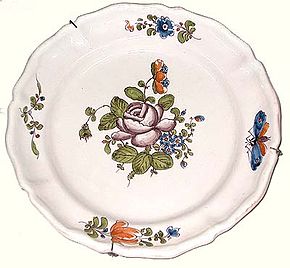|
The beginning: The Hustin factory
On November 13, 1714 Jacques Hustin, treasurer of the navy in Bordeaux, acquires the exclusive rights to manufacture and sell tin glazed pottery.
After this royal privilege is renewed until 1762, he retains a monopoly on the production of pottery in the Bordelais.
Initially, the production cannot compete with other pottery produced during the 18th century, due to problems with the attachment of the glazing to the clay.
Later on the production increases; the designs used are derived from those of Moustiers, Montpellier and the Far East.
|
|
After the monopoly ends in 1762, the potters settle in Bordeaux, the Bordeaux region, the Libournais and Gascony. Just before the revolution, there are eight pottery factories in Bordeaux. The production quantity is huge, but the quality is inferior to that of Hustins; the production is mainly for the petty bourgoisie and farmers, with its simple and not very original designs.
|

Bord van Bordeaux
|
|
The century of expansion: Vieillard and Co.
Lahens and Rateau establish a pottery factory in 1831 in Fouqueyrolles, which closes four years later. It is not until the Irishman David Johnston takes over the pottery, before the real development of the pottery industry in Bordeaux starts. He is assisted by Boudon de Saint-Amans, a former employee of Lahens and Rateau and an admirer of English pottery.
David Johnston opens a pottery in Bacalan where at some point 700 people work. He imports fuel and raw materials from England. The production becomes industrial, with printed designs in varied colors and patterns and with wavy edges.
In 1845 Jules Vieillard succeeds David Johnston. His way of business is crucial to the industrial successes of the plant in Bacalan, but also to the artistic quality of the products, which was unanimously applauded at the world exhibition. Hence we frequently speak of 'Vieillard' pottery.
Jules Vieillard starts looking for another source of raw materials, and finds it in Perigueux, Riberac and Bayonne. The objects with oriental designs, which he developed in his last years, are very popular amongst the fans.
The commercial success of Vieillard earthenware is substantial, and comparable to the pottery factories of Creil-Montereau. The products are widely sold in the Paris region, but also exported by ships leaving the port of Bordeaux.
In 1865 Vieillard's sons take over the company. They produce pottery with varied designs, mainly flowers and birds.
The factory closes in 1895.
Bron: Wikipedia
|




